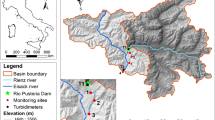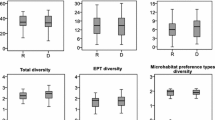Abstract
Macroinvertebrate assemblages of large alluvial streams are poorly documented. This study identified the physical characteristics affecting the macroinvertebrates community distribution in a large alluvial river devoid of major anthropogenic impacts. It was oriented towards the influence of the characteristics of the physical habitat (velocity, depth, grain-size classes of mineral substrates, macrophytes) on macroinvertebrates (richness, density, body size, feeding habits), with particular attention to the pollution-sensitive taxa. The study was carried out in June during a period of hydrological stability. The effects of water velocity, depth and substrates on taxa were evaluated with multivariate analyses. Mineral substrates were most abundant while macrophytes accounted for only 3% of sampled habitat. Invertebrates that were present were those characteristics of the transition zone between upper and middle life reaches. Among the 63 taxa sampled, 14 were abundant. In relation to the characteristics of the physical environment, the macroinvertebrate assemblages were discriminated by substrate, velocity, and depth. Habitat exploitation, however, appeared complex. The highest community richness, EPT richness, and density were found in various substrates where the velocity ranged between 30 and 120 cm s−1, depths ranged from 16 to 50 cm. The most pollution-sensitive taxa preferred riffle habitats with velocities >70 cm s−1 and substrate >64 mm. This suggest that rapid bioassessment programmes should be carried out in the mineral substrates of the geomorphological unit riffles where richness is high and density sufficient to represent the macroinvertebrate community, including pollution-sensitive taxa.
Similar content being viewed by others
References
AFNor, 1992. Essai des eaux- Détermination de l’indice biologique global normalisé (IBGN). Association française de normalisation, norme homologuée T-90-350
Armitage P. D., Moss D., Wright J. F. and Furse M. T. (1983). The performance of a new biological water quality score system based on macroinvertebrates over a wide range of unpolluted running-water sites. Water Research 17: 333–347
Barbour M. T., J. Gerritsen, B. D. Snyder & J. B. Stribling, 1999. Rapid Bioassessment Protocols For Use in Streams and Wadeable Rivers: Periphyton, Benthic Macroinvertebrates and Fish 2nd edn. EPA 841-B-99-002, U.S-Environmental Protection Agency, Washington, DC
Boyero L. (2003). The quantification of local substrate heterogeneity in streams and its significance for macroinvertebrates assemblages. Hydrobiologia 499: 161–168
Chester, R. K., 1980. Biological Monitoring Working Party. The 1978 national testing exercise: Technical Memorandum 19
Cummins K. W. and Klug M. J. (1979). Feeding ecology of stream invertebrates. Annual Reviews of Ecological Systems 10: 147–172
Cushing C. E. and Allan J. D. (2001). Streams, their Ecology and Life. Academic Press, San Diego
DEV (Deutsches Institut für Normung e.V.), 1992. Biologisch-ökologische Gewässergütentersuchung: Bestimmung des Saprobienindex (M2). In: Deutsche Einheitsverfahren zur Wasser-, Abwasser- und Schlammuntersuchung. VCH Verlagsgesellschaft mbH, Weinheim, 1–13
Vanhooren G. (1983). Method for biological quality assessment of water courses in Belgium. Hydrobiologia 100: 153–168
Downward S. R. (1995). Information for topographic survey. In: Gurnell, A. and Petts, G. (eds) Changing Rivers Channels, pp 303–323. Wiley and Sons Publishers, Chichester
Evans L. J. and Norris R. H. (1997). Predicition of benthic macroinvertebrate composition using microhabitat characteristics derived from stereophotography. Freshwater Biology 37: 621–633
Gayraud S., Statzner B., Bady P., Haybachp A., Schöll F., Usseglio-Polatera P. and Bacchi M. (2003). Invertebrate traits for the biomonitoring of large European rivers: an initial assessment of alternative metrics. Freshwater Biology 48: 2045–2064
Ghetti, P.F., 1997. Manuale di applicazione Indice Biotico Esteso (IBE). I macroinvertebrati nell’controllo della qualità degli ambienti di aque correnti. Provincia Autonoma di Trento, agenzia provinciale per la protezione dell’ambienti
Graça M. A. S., Pinto P., Cortes R., Coimbra N., Oliveira S., Morais M., Carvalho M. J. and Malo J. (2004). Factors affecting macroinvertebrate richness and diversity in Portuguese streams: a two-scale analysis. International Review of Hydrobiology 89: 151–164
Grubaugh J. W., Wallace J. B. and Houston E. S. (1996). Longitudinal changes of macroinvertebrate communities along an Appalachian stream continuum. Canadian Journal of Fisheries and Aquatic Sciences 53: 896–909
Hynes, H. B. N., 1986. Keynote Adress. In Dodge, D. P. (ed.), Proceedings of the International Large River Symposium. Canadian Special Publication of Fisheries and Aquatic Sciences 106: 5–10
Irvine K. (2004). Classifying ecologicla status under the European Water Framework Directive: the need for monitoring to account for natural variability. Aquatic Conservation: Marine and Freshwater Ecosystems 14: 107–112
Ivol-Rigaut J.-M, Guinand B., Richoux P. and Tachet H. (1997). Longitudinal changes in Trichoptera and Coleoptera assemblages and environmental conditions in the Loire River (France). Archiv für Hydrobiology 138: 525–557
Karr J. R. (1999). Defining and measuring river health. Freshwater Biology 41: 221–234
Klemm, D. J., P. A. Lewis, F. Fulk & J. M. Lazorchak, 1990. Macroinvertebrate Field and Laboratory Methods for Evaluating the Biological Integrity of Surface Waters, EPA. 600/4-90/030, Environmental Monitoring Systems Laboratory, Office of Modeling, Monitoring Systems and Quality Assurances, Office of Research and Development, U.S. Environmental Protection Agency, Cincinnati, OH
Leopold L. B. (1994). A view of the River. Harvard University Press, Cambridge, Massachusetts
Linhart J., Vlčkova S. and Uvíra V. (2002). Moss-dwelling meiobenthos and flow velocity in low-order streams. Acta Universalis Palackianae Olomucensis Facultas Rerum Naturalium (2001–2002). Biologica 39–40: 111–122
Logan P. and Furse M. (2002). Preparing for the European Water Framework Directive making the links between habitat and aquatic biota. Aquatic Conservatrion: Marine and Freshwater Ecosystems 12: 425–437
Malavoi J. R and Souchon Y. (2002). Description standardisée des principaux faciès d’écoulement observables en rivière: clé de détermination qualitative et mesures physiques. Bulletin Français de la Pêche et de la Pisciculture 365/366: 357–372
Maridet L., Wasson J.-G., Philippe M., Amoros C. and Naiman R. J. (1998). Trophic structure of three streams with contrasting riparian vegetation and geomorphology. Archiv für Hydrobiology 144: 61–85
Mérigoux S. and Dolédec S. (2004). Hydraulic requirements of stream communities: a case of study on invertebrates. Freshwater Biology 49: 600–613
Minshall, G. W., 1984. Aquatic insect- substratum relationships. In Resh, V. H. & D. M. Rosenberg Publishers. The ecology of aquatic insects, Praeger, New-York: 358–400
Monakov A. B. (2003). Feeding of Freshwater Invertebrates. Kenobi productions, Belgium
Nelson S. M. and Lieberman D. M. (2002). The influence of flow and other environmental factors on benthic invertebrates in the Sacramento River, USA. Hydrobiologia 489: 117–129
Plotnikoff R. and Wiseman C. (2001). Benthic Macroinvertebrate Biological Monitoring Protocols for Rivers and Streams. Dept. Ecology. Olympia, Washington
Rempel L. L., Richardson J. S. and Healey M. C. (2000). Macroinvertebrates community structure along gradients of hydraulic and sedimentary conditions in a large gravel-bed river. Freshwater Biology 45: 57–73
Reynoldson T. B., Norris R. H., Resh V. H., Day K. E. and Rosenberg D. M. (1997). The reference condition: a comparison of multimetric and multivariate approaches to assess water-quality impairment using benthic macroinvertebrates. Journal of the North American Benthological Society 16: 833–852
Richards C., Haro R. J., Johnson L. C. and Host G. E. (1997). Catchment and reach-scale properties as indicators of macroinvertebrate species traits. Freshwater Biology 37: 219–230
Rosenberg D. M. and Resh V. H. (1993). Freshwater Monitoring and Benthic Macroinvertebrates. Chapman & Hall Publishers, New York
Skriver, J., N. Friberg & J. Kirkegaard, 2000. Biological assessment of water course quality in denmark: introduction of the Danish Stream Fauna Index (DSFI) as the official biomonitoring method. – Verhandlungen. Internationale Vereinigung Für Theoretische und Angewandte Limnologie 27: 1822
Smith M. J., Ky W. R., Edward H. D, Papas P. J., Richardson K. St J., Simpson J. C., Pinder A. M., Dale D. J., Horwitz P.H.J., Davis J. A., Yung F. H., Norris R. H. and Halse S. A. (1999). AusRivAS: using macroinvertebrates to assess ecological condition of rivers in Western Australia. Freshwater Biology 41: 269–282
(1999). SPSS version 10.0 for Windows. SPSS Inc, Chicago
Southwood T. R. E. (1977). Habitat, the templet for ecological strategies. Journal of Animal Ecology 46: 337–365
Southwood T. R. E. (1988). Tactics, strategies and templets. Oikos 52: 3–18
Statzner B., Gore J. A. and Resh V. H. (1988). Hydraulic stream ecology: observed patterns and potential applications. Journal of the North American Society 7: 307–360
Strahler A. N. (1957). Quantitative analysis of watershed geomorphology. Transactions of the American Geophysical Union 38: 913–920
Tachet H., Richoux P., Bournaud M. and Usseglio-Polatera P. (2000). Invertébrés d’eau douce. Systématique, biologie, écologie. CNRS Editions, Paris
Thioulouse J., Chessel D., Dolédec S. and Olivier J. M. (1997). A multivariate analysis and graphical display software. Statistics and Computing 7: 75–83
Townsend C. R. (1989). The patch dynamics concept of stream community ecology. Journal of the North American Benthological Society 8: 36–50
Townsend C. R. and Hildrew A. G. (1994). Species traits in relation to a habitat templet for river systems. Freshwater Biology 31: 265–275
Verneaux, J., 1994. Macrobenthos et l’état de santé des eaux douces. Fondements, contraintes et perspectives. In Etat de santé des écosystèmes aquatiques. Les variables biologiques comme indicateurs- Acte du séminaire national – Cemagref editions
Wallace J. B., Grubaugh J. W. and Whiles M. R. (1996). Biotic indices and stream ecosystem processes: results from an experimental study. Ecological Applications 6: 140–151
Ward J. V. (1992). Biology and Habitat. In Aquatic Insect Ecology 1. John Wiley & Sons Publishers, New York
Woodiwiss F. S. (1964). The biological system of stream classification used by Trent River Board. Chemistry and Industry 83: 443–447
Wohl D. L., Wallace J. B. and Meyer J. L. (1995). Benthic macroinvertebrates community structure, function and production with respect to habitat type, reach and drainage basin in the Southern Appalachians (USA). Freshwater Biology 34: 447–464
Wright J. F., Armitage P. D., Furse M. T. and Moss D. (1984). The classification of sites on British rivers using macroinvertebrates. Verhandlungen der Internationalen Vereiningung für Theoretische und Angewandte Limnologie 22: 1939–1943
Zar J. H. (1999). Biostatistical Analysis. Prentice Hall Publishers, New Jersey
Author information
Authors and Affiliations
Corresponding author
Rights and permissions
About this article
Cite this article
Beauger, A., Lair, N., Reyes-Marchant, P. et al. The distribution of macroinvertebrate assemblages in a reach of the River Allier (France), in relation to riverbed characteristics. Hydrobiologia 571, 63–76 (2006). https://doi.org/10.1007/s10750-006-0217-x
Received:
Revised:
Accepted:
Published:
Issue Date:
DOI: https://doi.org/10.1007/s10750-006-0217-x




